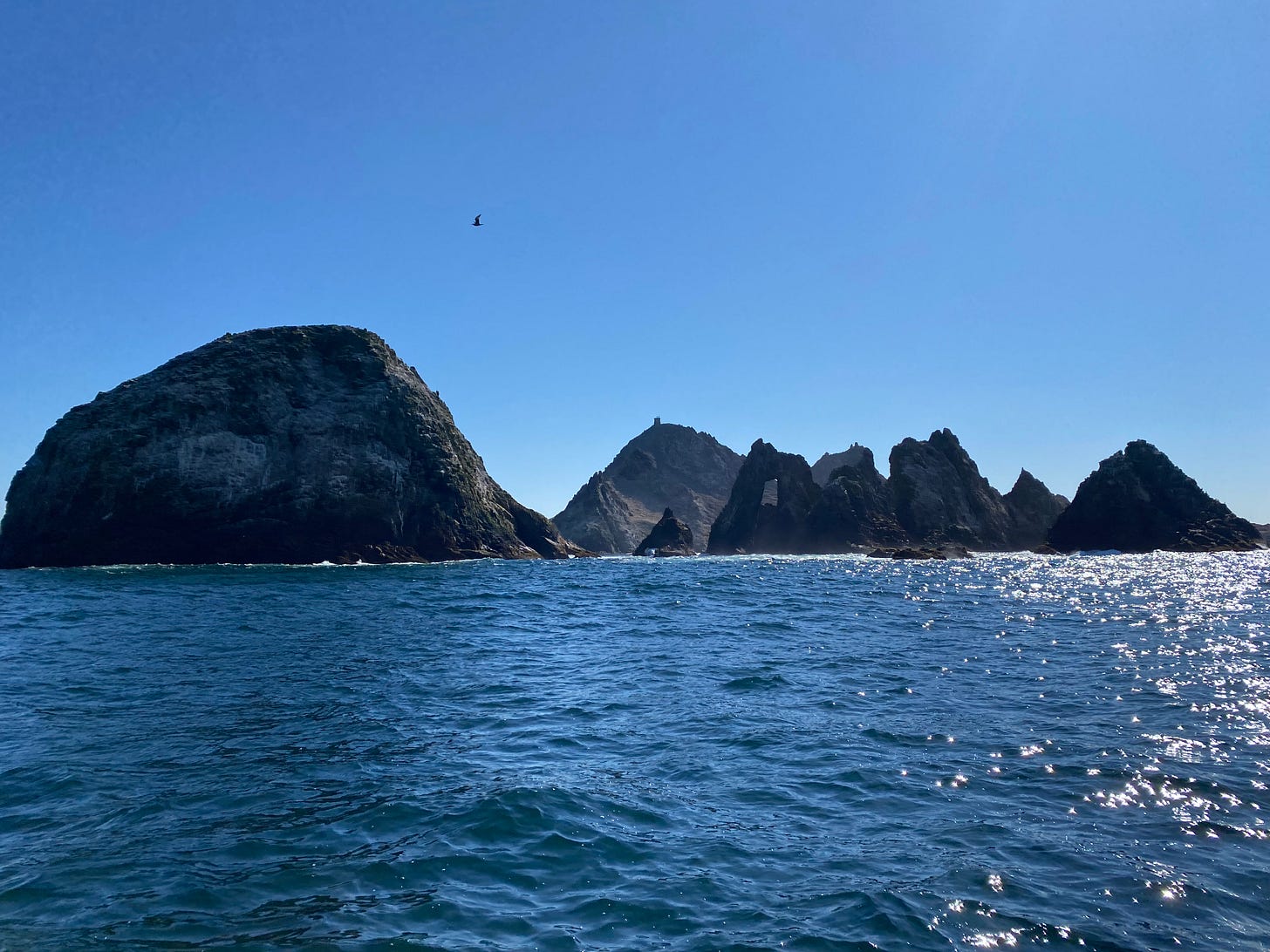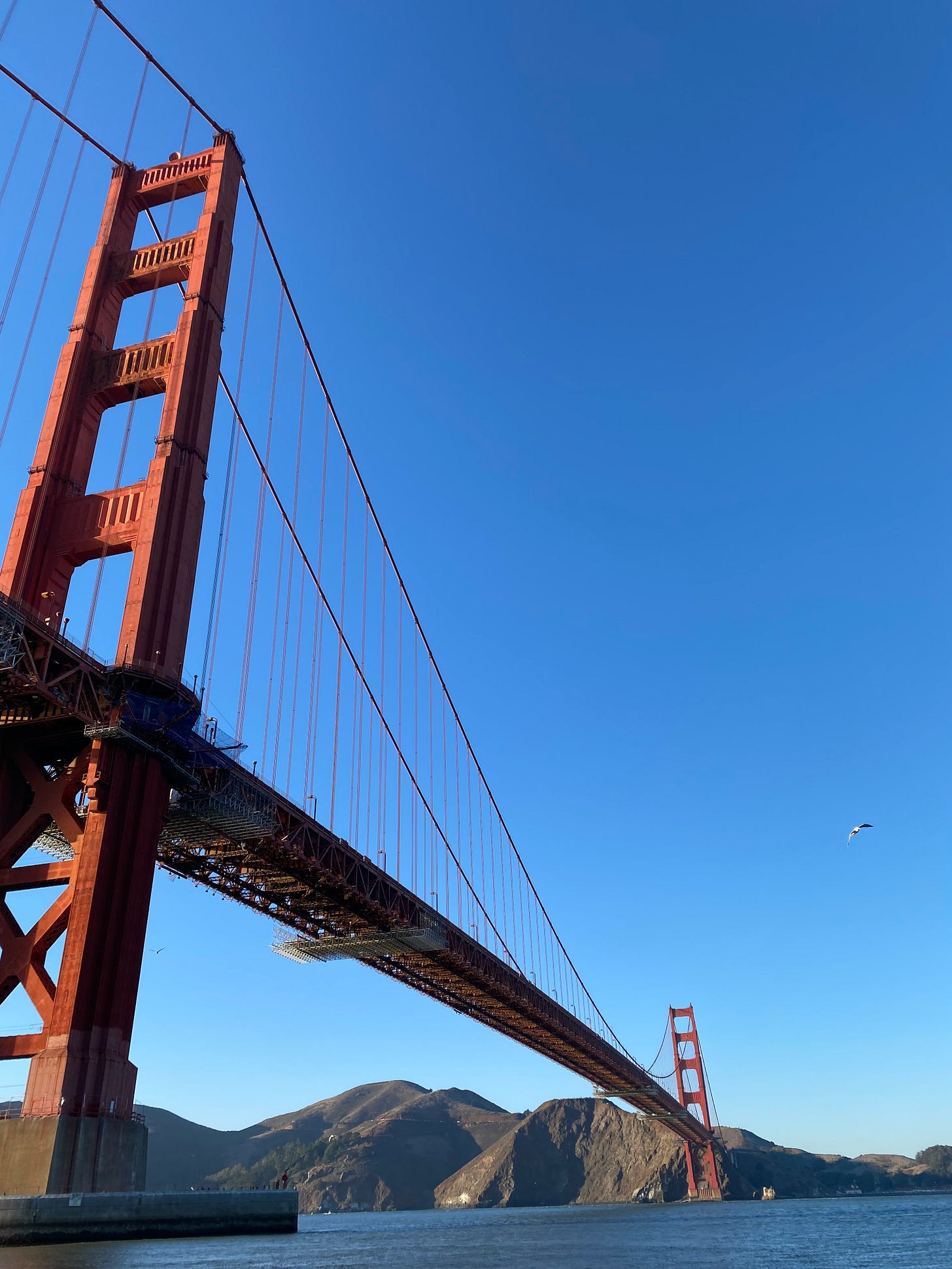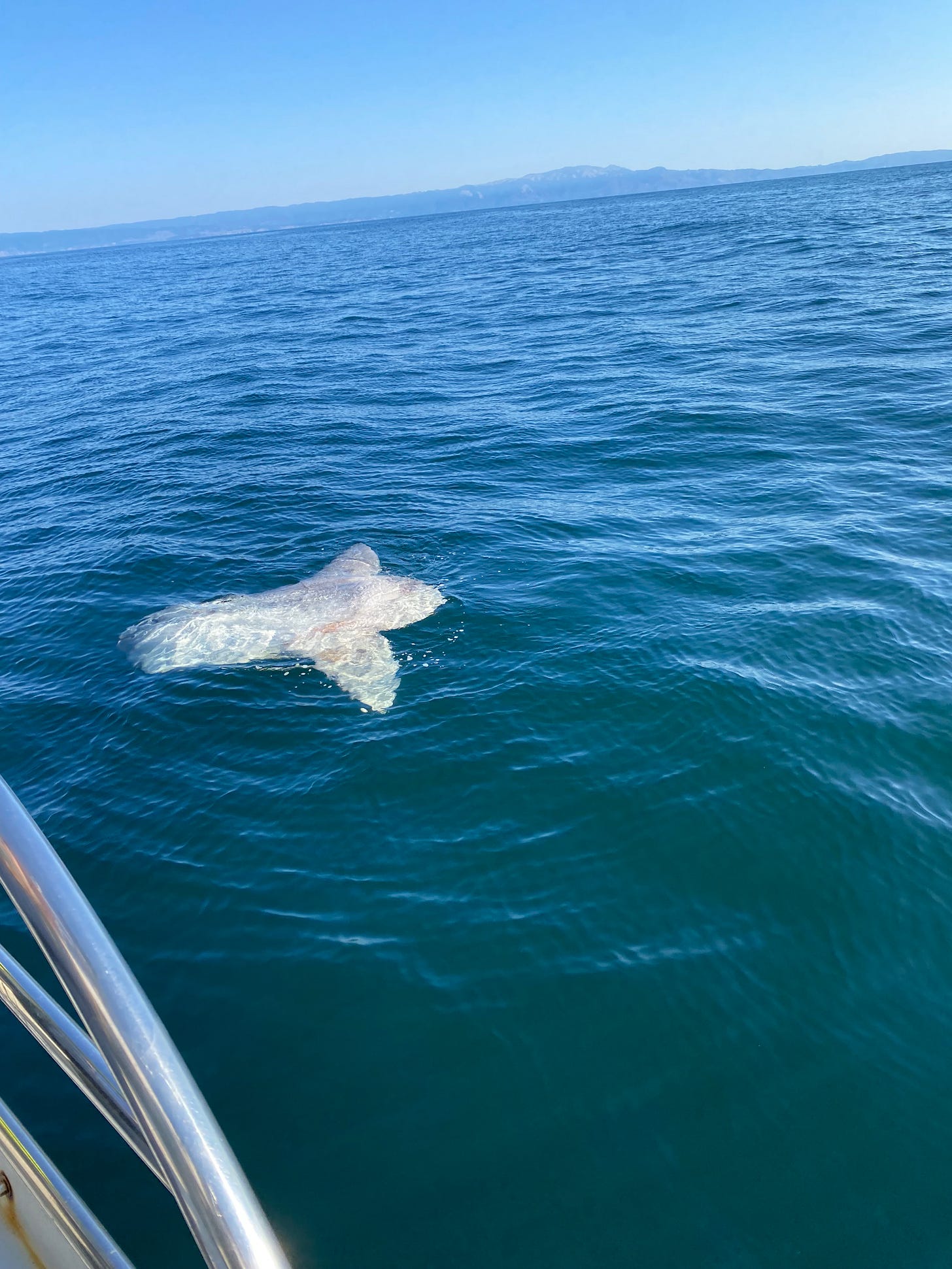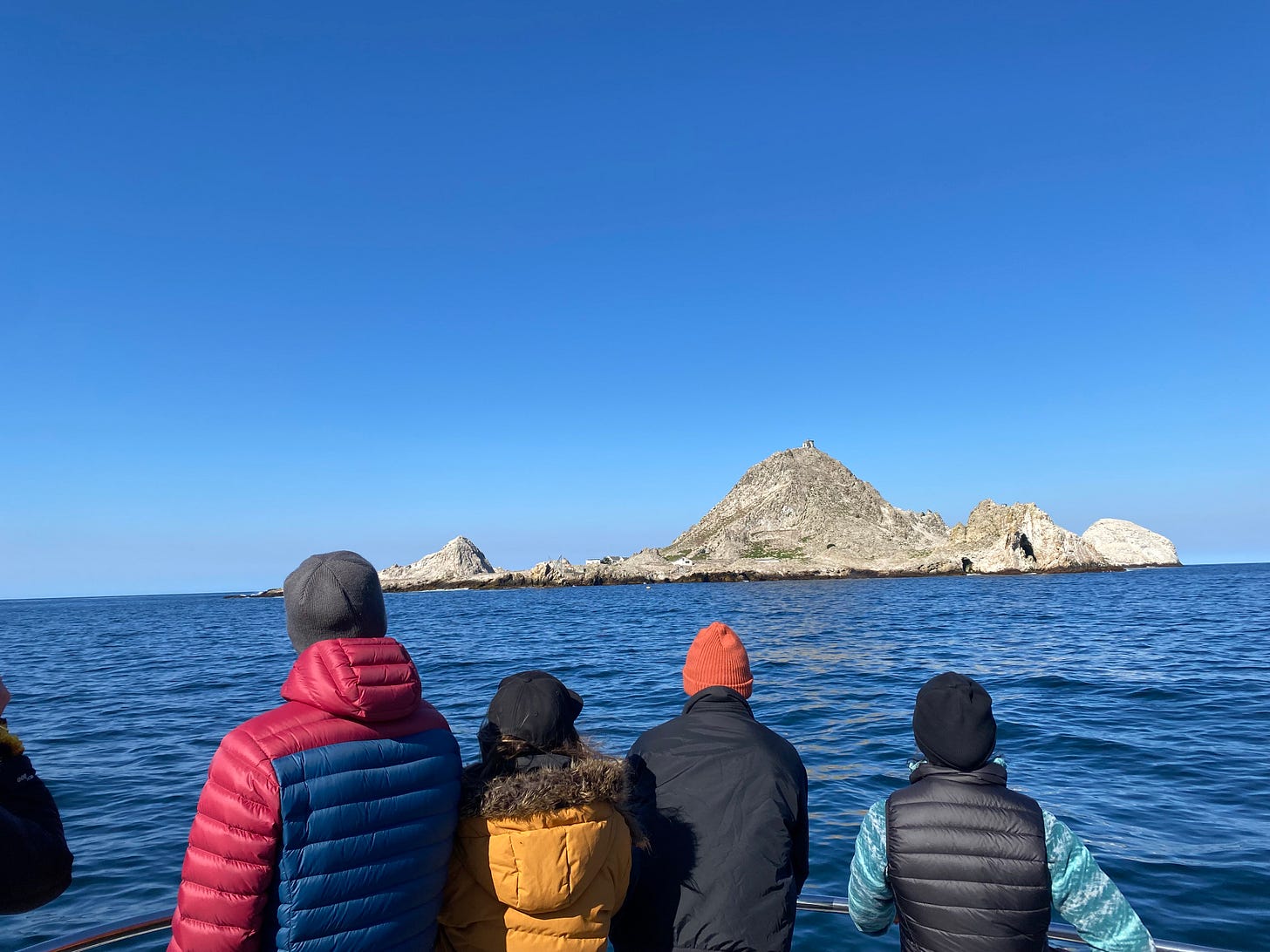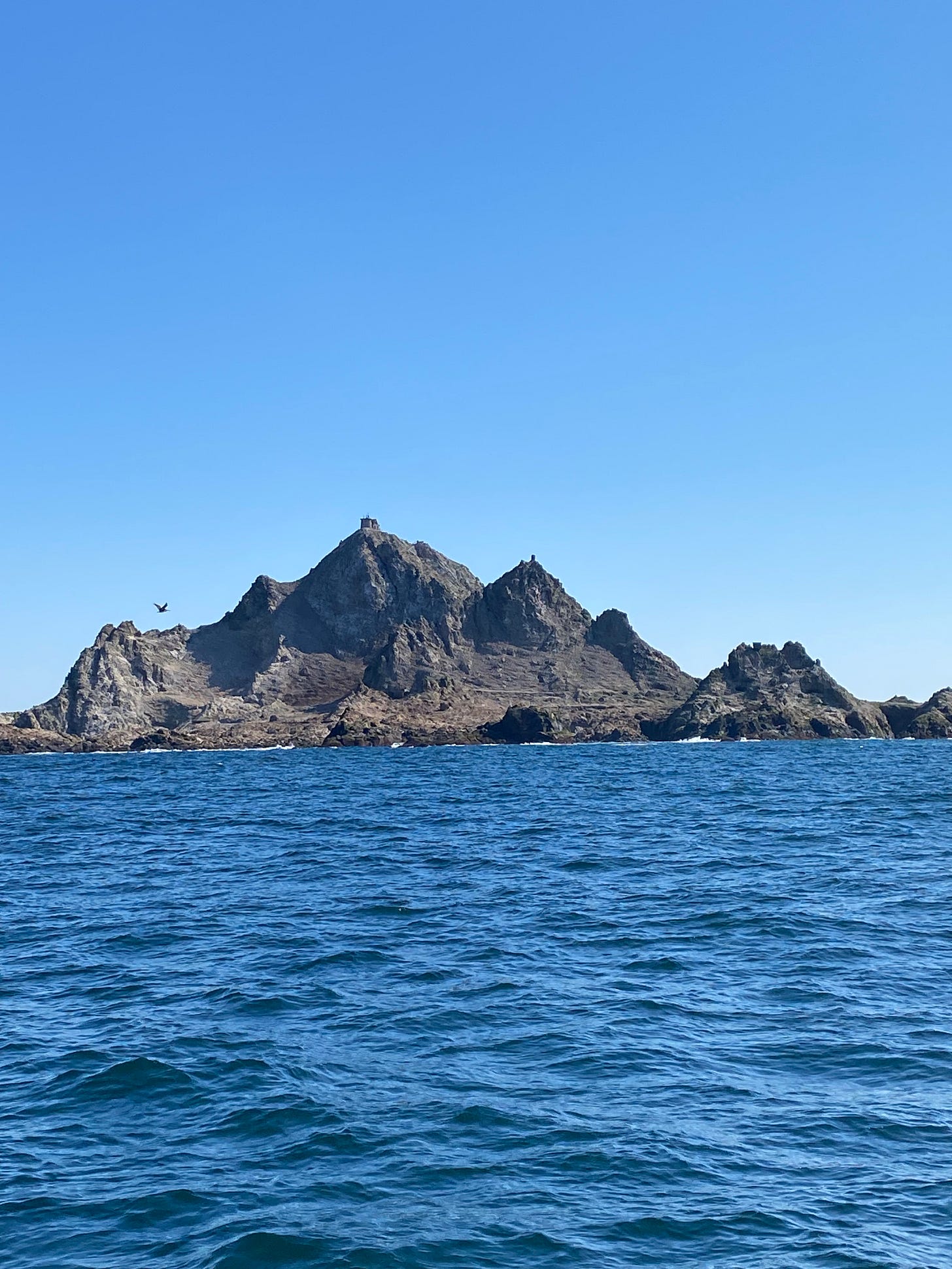“And in this foreboding spot, humans were neither wanted nor needed. The usual rules of civilization did not apply. Here was a place where nothing was fake and nothing was for sale, where cars and credit cards, cell phones and expensive high-heeled shoes got you nowhere, where animals thrived while people died in any number of unlikely ways. This lost outpost, it seemed to me, was more than an unexpected scrap of America, more than a window into an interesting marine world. It was a glimpse into another realm.”
-Susan Casey, The Devil’s Teeth
The Pacific ocean has a way of putting things in perspective. From this distance even the Salesforce tower, normally the phallic eye of Sauron dominating the SF skyline, shrinks down to a more appropriate size in the chilly morning air.
Earlier, as we passed under the Golden Gate Bridge a group of harbor porpoises had surfaced and swam around our boat, beckoning us out to sea. This was a good omen, I’d reckoned.
Staring at the open ocean I wonder: if charismatic marine mammals had already danced around our boat while it was still in the Bay, what other visitors await us at the Farallons?
When Alexis told me she’d gotten us a shark watching trip to the Farallon Islands for our anniversary I was ecstatic. We were going to get the chance to visit one of the most mysterious parts of Northern California and home to some of the world’s largest great white sharks
My childhood obsession with sharks had somehow taken on new dimensions as an adult after I read The Devil’s Teeth by Susan Casey. In this page-turning book, Casey recounts how after visiting the Farallon Islands as a journalist she found herself utterly captivated by the wild and windswept location, the quirky scientists living there, and the impossibly large sharks patrolling the frigid and treacherous ocean surrounding them. This enthusiasm is palpable in Casey’s prose. Her book is full of intense, evocative descriptions of these enigmatic predators like:
“Then, off the bow, I saw a tail that dwarfed the others. It looked more like the tail of a Gulfstrem jet than of a fish, and it moved with the languorous swishy motion of a runway model. It was so enormous that even with its back end next to the boat, I couldn’t make out the front half of the animal. This shark had a different aura…she swam with unbelievable power and unlikely grace, a Sherman tank making dressage moves.”
The ocean itself becomes a raging beast in Casey’s writing, too:
“Moonlight glanced off seething boils in the gulch beneath the boom, and surf exploded against the cliff, shattering like a crystal goblet hurled at a wall.”
Even rocks are somehow exciting when she describes them:
“It was rock as imagined by a cubist on peyote, a mad jumble of stone veined by seawater and runneled with elemental abuse.”
I’d never read nature writing like this. Nor had I quite grasped just how close my childhood home was to the Mecca for my childhood obsession. On clear days I’d seen the Farallons from West Marin, perched on the horizon like birds on a telephone wire, tantalizingly close. I burned through this book on my Kindle in 72 hours and emerged determined that I too had to visit these mysterious islands one day.
As we mill about on the boat deck in the frigid pre-dawn clutching coffee I can see that I’m not the only shark super fan onboard. Our boat, The Amigo, is full of people like me. Our resident scientist David McGuire is wearing an ocean blue hoodie with a great white on it. There’s a lady wearing a long sleeve thermal shirt speckled with sharks and another wearing a shark sweatshirt complete with teeth on the hood and a fin on the back.
Another woman mentions she has a shark tattoo on her shoulder. She then shows it to me with very little prompting despite the cold— an enormous rendition of a cat shark. We start discussing our favorite sharks the way some people discuss their favorite video games. Then we begin to discuss our favorite video games. She works in healthcare and is here with her boss as a sort of work outing. It strikes me that this is one of those people I might never meet in my normal life, but on this blustery boat deck eagerly awaiting shark spotting we are suddenly the best of friends.
Off the coast of Stinson, the boat slows and McGuire ushers us to one side of the railing. There is something staggeringly large right at the surface. I look at the water. When I see it I almost start laughing.
A sunfish looks like a child started drawing a fish and stopped after his dad told him to make it look more realistic. All that’s there is an enormous head with fins attached, as if the child just refused to finish drawing the creature. They’re impossibly huge, flat ovals that looking equally cartoonish and alien.
While they swim vertically, they often come up to the surface to bask in the sun, hence the name. In this orientation, they look especially ridiculous. They grow up to 10 feet long and 2,000 pounds. McGuire estimates this one is between 30 and 40 years old. We haven’t even gotten to the Farallons yet and here I am staring at a fish that weighs as much as our car and may be as old as I am.
The Farallons are a primordial frontier between sea and rock, the last specks of land before the Pacific continental shelf drops two miles into the deep ocean. Thanks to this underwater geography, freezing water upwells here, bringing with it nutrients from the seafloor. This makes these windy and rocky outcrops a home and breeding ground for seabirds as well as seals, sea lions, and elephant seals.
The density of these fatty pinnipeds is the reason that the Farallons are one of the stations of the cross for Pacific great white shark migration. The other ones are Guadalupe Island off the coast of Mexico and "the great white shark cafe,” a remote stretch of ocean between Hawaii and Baja where scientists believe sharks to go find and impress a mate. One scientist at the Monterey Bay Aquarium dubbed this area “burning man for great white sharks.”
During the fall, great whites congregate in the cold waters around the Farallons to feed on the many blubbery sausages sunning themselves on the rocks. This seasonal arrival has been dubbed “sharktober.” It’s one of the sharkiest times of year at one of the sharkiest places on earth.
Great white sharks, like the elephant seals they prefer to hunt, display sexual dimorphism. Unlike elephant seals, it’s the female sharks that are the largest. While male white sharks top out around 15 feet, females can grow to 19 feet. When the enormity of this hit home while reading Devil’s Teeth, I put down my kindle and got a measuring tape. I ran out of measuring tape and living room before I could reach 19 feet.
A murmur of excitement ripples down the boat as the islands pierce the horizon like a dorsal fin. The anticipation is palpable in the salt air. I half expect the “Journey to the Island” theme from Jurassic Park to begin playing at any moment. As we get closer, the staggering remoteness of the setting slides into focus.
McGuire informs us that the coastal Miwok and Ohlone people called this place the islands of the dead, believing that the spirits of the deceased went there. The Spanish named them Los Farallones, for the cliffs of steep rocks that emerged from the violent swells of the Pacific. English speakers had christened them “the devil’s teeth” because of how dangerous both the visible and submerged rocks were for passing ships. Many boats and people had been lost here over the years. To protect maritime traffic from these jagged islands that were so often shrouded in fog, the second lighthouse on the West coast was built on Southeast Farallon Island in 1855. This island is the largest and the only inhabitable one and had 70 people living there at one point. However, the automation of lighthouses and a marine conservation act passed by Teddy Roosevelt changed all that. Today a handful of scientists are the only ones allowed to set foot there and the only occupants of the two permanent structures on its blustery surface, the former residence of the lighthouse keeper and his family.
We’re just 27 miles off the coast of San Francisco but I feel like we are on another planet. Language begins to fail me and profound, primal feelings nestle into my heart to take its place. My concept of the Bay Area blows away in the wind as I take in the vastness of this place that is somehow deeply inhospitable yet teeming with life. Here there is just the howling of the wind and the crashing of the waves, the barking of the seals and the cawing of seabirds. Implicit in all this but invisible for now, are the sharks.
“If there is a predation event, look for the birds. Birds will always descend after a shark bites a seal to try to eat the scraps. Elephant seal blood also has a lot of myoglobin in it, so it looks like a bright red oil slick. You won’t miss it,” McGuire says.
We are parked in Mirounga Bay, named after the elephant seals that live there. While white sharks will eat seals and sea lions, they prefer elephant seals if they’re around. They’re are larger and fattier, making them a more substantive meal that’s also easier to catch. Small seals corner faster than whites can, which frustrates the sharks.
Seals are everywhere, but their Manhattan appears to be saddle rock, a smaller island just off of Southeast Farallon. It is swarming with thousands of seabirds, whose droppings have turned them a particular shade of beige. The lower section of the island is crawling with plump seals, galumphing along in the loud and lazy way that only seals can.
I’m astounded by how bad it smells. The sheer quantity of bird shit and seal poop produce a noxious cloud that occasionally drifts across the boat and overpowers my senses. What no one tells you about a marine sanctuary is that it’s also a marine bathroom.
We get word from the scientists atop the lighthouse that sharks had been spotted hunting in the crescent of foam between the rock to the main island. The seals keep sunning themselves, oblivious to the threat. We begin watching this stretch of water intently. I lower my binoculars, wondering how I’ll react when I see a big one.
“Babe, all seals do is nap, shout, and occasionally eat,” I remark to Alexis.
“What a life,” she replies, gnawing on some beef jerky.
Seals here occasionally pay the ultimate price for their slothful existence. As they commute between rocky outcroppings to eat, sun, mate, or visit family members, they have to contend with colossal great whites emerging from the depths like a vengeful old testament god, trying to decapitate them with one powerful bite.
I shudder and peek anxiously over the side of the boat. All I can see are ghostly moon jellyfish pulsing just beneath the surface.
McGuire prowls the deck nearby. I have been a fan boy long enough. I’m not sure when I’ll meet a shark scientist again and have to make the most of this moment. I walk up to him and ask:
“What’s the biggest shark you’ve ever seen?”
“18 or 19 footer.”
“Here?”
“No, Guadalupe Island. Shark Stewards sent a group of us down there. It was incredible.”
“Ah Baja. I hear the visibility is really good. Didn’t the government just ban cage diving?”
”Yeah, it’s gotten complicated. They had too many people trying to visit and they just shut it down rather than try to figure out a better way forward. I’m hopeful they’ll reopen it one day.”
Talk inevitably turns to white shark attacks on abalone and urchin divers. McGuire has thoughts on this.
“Almost all diver attacks tend to happen at the surface. Great whites are curious by nature.”
I recall that, while trying to cook an entirely local Bay Area meal while writing The Omnivore’s Dilemma, Michael Pollan cancelled plans to try harvesting abalone after an abalone diver was decapitated by a 16-18 foot great white shark at 10 mile beach North of Fort Bragg. McGuire has heard about this attack too and doesn’t mince words.
“He likely dove right into that sharks mouth.”
I mention the sea urchin diver who still harvests urchin off the Farallons. He’d been a minor character in The Devil’s Teeth.
“Oh Ron. He’s a legend. Though he may not be all there to do what he does.”
I agree. Ron Elliot seemes like the Alex Honnold of the ocean, someone who lacks the healthy terror that kept the rest of us mortals away from where and how he pursues his passion. In The Devil’s Teeth, Casey describes Ron’s many brushes with the resident sharks as he gathered urchins.
A decade after it’s publication, Ron had the ultimate close call with a huge great white here in 2017. The video went viral and is one of the most chilling shark encounters I’ve ever seen.
Not one to quit while he was ahead, Elliot was bitten on the hand by a 17 foot great white while filming another video just a year after this close call.
McGuire and his team deploy an underwater drone to look for sharks. As the drone swims in circles around the boat, scouting out the seafloor, McGuire points back towards San Francisco. There is a sailboat with a shark cage on the back. He looks at their operation dismissively.
“I’d never cage dive here. You pay a bunch of money to get really cold. Even if there are sharks around, you can’t see them because the water is so murky. The sharks have no interest in the cages. They’ll swim by once to check them out and then leave.”
He explains that chumming the water to attract sharks, a common tactic elsewhere, is banned in the Farallons. He elaborates that educational operations like ours used to use decoys shaped like seals to tempt curious sharks by the boat, but the state government has recently banned that, too.
“The federal government has no issue with decoys but the state of California does for some reason. So we’re caught in regulatory limbo for now.”
Neither the drone nor anyone on deck sees any sign of great whites. So we sit down to eat our lunch. Someone jokes they are going to start referring to all of their meals as predation events. I chuckle and go to fetch my sandwich. No sooner has my butt touched the cold metal bench than someone shouts from across the boat:
“SHARK!”
The deck buzzes with excitement. Phones and binoculars are brandished and pointed hopefully towards the horizon. Some people are already recording videos. Then, halfway between me and the horizon I see it.
“Sweet suffering seals, that’s big.”
I see the thrashing first. A staggeringly large dorsal fin and tail fin slice laterally through the water, the white shark beneath corning aggressively to pursue its prey. I’ve always imagined that Hollywood overplays how prominent shark fins are in the water, but even from a hundred yards away this one is larger and more imposing than I could have imagined. What’s most surprising to me is how it’s the tail fin, not the dorsal fin that’s most prominent, at least twice the size of the already huge dorsal.
Then, just like that, it’s gone. How could something so huge disappear so quickly and silently? The white shark’s credentials as an ambush predator slide into stark relief. I shudder sympathetically for the seals, imagining how mice must feel about owls. How could you ever relax knowing that something like that is out there hunting for you with the persistency of a Nazgûl, gliding through the environment as silently as a stealth bomber? My imagination runs wild. As awe-inspiring as the shark we have just seen is imagining all the ones we can’t see.
McGuire asks who on board has read The Devil’s Teeth and a few hands shoot up, including mine and the lady in the shark print thermal shirt.
He claims Casey fictionalized and potentially plagiarized chunks of the book. He recommends reading Farallons: Sentinels of the Golden Gate, by Peter White, which he says is much more scientific and accurate. He elaborates that while Casey’s writing is undeniably florid and evocative, her personal obsession with the Farallons had caused a lot of collateral damage, resulting in the loss of a sailboat and the white shark project getting shut down for two years. The very research project she built much of her page-turning story around got the hug of death from all the attention she drew to these remote islands. Casey got to cozy up with shark researchers and visit the islands three times in her book, but this boat is the closest any of us will ever get to the Farallons.
While McGuire’s take on Susan Casey rocks my worldview, I realize that the opinion of one salty scientist probably doesn’t concern her at all at this point. She has since moved on to other oceanic obsessions, penning a book about big waves where she got to hang out with famous surfer Laird Hamilton, writing one about dolphins, and most recently The Underworld about the deep ocean. Through this work she’s become a pop nonfiction ocean authority, a sort of Michael Pollan for the sea.
It was during her deep ocean obsession that the Oceangate disaster happened. In response, she penned a vehemently worded article in Vanity Fair excoriating Stockton Rush for his arrogance and greed in the face of the uncompromising forces of the deep sea. If she’d learned one thing from all of her time spent at sea interviewing the various experts that populated the pages of her books, it was that it was a grave error to disrespect the power of the ocean. Even our grandest ambitions are just fragile playthings the moment you submerge them in the water
We do a lap around the island. Southeast Farallon Island doesn’t have a bad angle. Each side is someone more beautiful and rugged than the last. The North side is a minefield of jagged offshore rocks. I can see why the craggy hilltop dominating this island was chosen for the lighthouse. The alternative was near certain shipwreck and drowning thanks to the thick fog, fast currents, and huge waves, death by sea or shark.
It’s hard to deny the beauty beneath the inhospitable facade. The way the afternoon light slants through the dramatic rock arch looks straight out of a painting. As we arrive back at Mirounga Bay I can’t believe the day is almost over.
Riding high on the palpable hype and obsession in the pages of Devil’s Teeth, I had arrived on the dock early this morning with high hopes. My expectations have been tempered by reality, though in an informative, not disappointing way.
All in all I’ve seen thousands of birds, hundreds of seals and sea lions, dozens of jellyfish, and one chunky sun fish. I have barely seen the one thing I came here dying to see yet feel sublimely at peace with it all.
It’s undeniable that the Farallons are as beautiful as they are indifferent to me. As the confirmation email had told us in plain english, there is never a guarantee of seeing a shark or anything, for that matter. Nature does not arrange or edit itself for my enjoyment.
In a world where we often enter experiences anxious about whether they will be the optimum version of that type of content, visiting natural environments often capsizes this way of thinking.
Compared to a nature documentary, where the slow bits are trimmed out and the juiciest action is slowed down and edited, a trip like this requires patience and curiosity. It’s a type 2 kind of fun that a few of the teenagers on board seemed to find boring. Yet as the boat motors away from the island and the swells rock a dramamine-saturated Alexis to sleep next to me, I felt deeply content.
Trips like this are a great change of perspective. Staring at the unfathomably vast Pacific, it’s hard to not feel small and insignificant, which somehow also makes me feel more important. Facing the cold indifference of the ocean I reaffirm that life is indeed sacred and interconnected.
I’ve never been a religious person, but often feel at my most spiritual when I’m in, near, or on the Pacific ocean. The ocean moves me in the same way that churches, chanting, and concerts do for others. Heading somewhere as remote as the Farallons has felt deeply grounding and invigorating for me.
I am about to nod off alongside Alexis when the boat suddenly stops again. Someone has spotted an enormous gray fin and something huge beneath it. Surely it’s a shark. Cameras and binoculars are pulled out again and steadied amidst the rolling swells on deck. This has to be it. I see the fin for myself and the mass of grey beneath it, taking in the enormous size of the fish right next to the boat when I realize…
It is fool’s gold, just another sunfish. Its fin juts out of the water like a periscope. These derpy fish have inadvertently become the stars of the day.
Halfway between West Marin and the Golden Gate Bridge we see the largest beast of the day. The captain slows the boat and we wait for it to surface again. I’m giddy. I’ve never seen a whale outside of a Pacific Life Insurance commercial. I recall with embarrassment how as a kid I’d found whales boring compared to sharks, lacking the sharp, dangerous edges young boys require of their obsessions.
Now, confronted with it head on I find its suddenness and size to be awe-inspiring. No sooner has it surfaced and exhaled than it arcs back down and vanishes again. It doesn’t do the trademark fluke with its tail, McGuire says, because the water here is too shallow.
We all crowd towards the bow clutching cameras, trying to document the enormity of what we’ve just seen when the whale surfaces again. It’s a humpback, McGuire says, at least thirty feet long, and only an adolescent by his estimates. It keeps us guessing, surfacing at various distances and compass orientations around the boat. This unpredictable pattern, coupled with the fact that it is only ever above water for a second makes it impossible to film, much less photograph amidst the jostling arms and rocking swells of the deck. I put my phone away before it flies into the Pacific.
The buzz quiets. No one has seen the whale in minutes. We wonder aloud if it has left us for good when it lunges right right by the bow of the boat. It’s taking its time feeding, scooping up hundreds of gallons of seawater full of krill and small fish and splashing back into the ocean.
The captain lets know this show off of a whale has put us behind schedule. We need to head back to San Francisco in a matter of minutes.
The humpback swims on, leisurely feeding, unaware of time constraints and unbothered by the boat. It breaches one last time, lunging up at the sun as it gulps another mouthful of seawater. As it turns, its pectoral fun tilts up towards the sky, almost like it’s waving hello, or waving goodbye.
Author’s Note: If you want to visit the Farallons, which I’d highly recommend, the organization we booked our tour through is called Shark Stewards. Your ticket price for one of their expeditions helps fund shark conservation efforts. Just be sure to pack layers and bring dramamine.
Like what you just read? A free or paid subscription can’t prevent shark attacks but it can support my writing.
Have thoughts about sharks, nature, The Devil’s Teeth, or the ocean?
Do you know someone that would enjoy this article? Share it with them.

